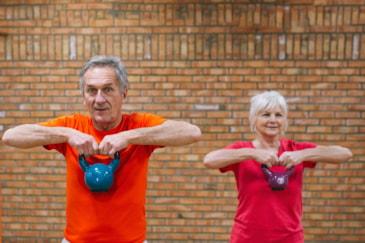Strength Training After 60: Building Strength and Vitality in Your Golden Years
For seniors, strength training isn’t just about building muscle or looking fit; it’s about maintaining independence, enhancing mobility, preventing injuries, and improving overall health.
Aging is a natural process, but maintaining strength and vitality well into your golden years is possible—and strength training is key to achieving that. For individuals over 60, strength training isn’t just about building muscle or looking fit; it’s about maintaining independence, enhancing mobility, preventing injuries, and improving overall health. In fact, experts today emphasize that strength training is one of the most important components of fitness as we age.
In 2024, strength training for seniors is more accessible than ever, with tailored programs, expert guidance, and technological innovations designed specifically to meet the needs of older adults. Let’s explore the benefits of strength training after 60, common myths, and how you can safely get started on your path to stronger, healthier aging.
Why Strength Training is Critical After 60
 The natural aging process often leads to a decline in muscle mass, bone density, and strength. This condition, known as sarcopenia, can begin as early as your 30s but accelerates after 60. Without strength training, you may lose up to 5% of muscle mass per decade, leading to weaker muscles, decreased mobility, and higher risk of falls and fractures.
The natural aging process often leads to a decline in muscle mass, bone density, and strength. This condition, known as sarcopenia, can begin as early as your 30s but accelerates after 60. Without strength training, you may lose up to 5% of muscle mass per decade, leading to weaker muscles, decreased mobility, and higher risk of falls and fractures.
Here are some of the most critical benefits of strength training for older adults:
- Prevents Muscle Loss: Strength training helps rebuild and maintain muscle mass, counteracting the effects of sarcopenia.
- Improves Bone Density: Weight-bearing exercises stimulate bone growth, reducing the risk of osteoporosis and fractures, which become more common after 60.
- Boosts Metabolism: As you build muscle, your body burns calories more efficiently, helping to manage weight and reduce the risk of obesity and related diseases.
- Enhances Mobility and Flexibility: Strong muscles support your joints, making it easier to perform daily activities like walking, climbing stairs, and bending without discomfort.
- Reduces the Risk of Falls: Stronger muscles, particularly in the legs and core, improve balance and coordination, significantly reducing the risk of falls.
- Improves Mental Health: Regular exercise, including strength training, releases endorphins, which boost mood, reduce anxiety, and improve overall mental well-being.
- Promotes Independence: Maintaining strength means staying independent longer, allowing you to continue doing the things you love without relying on assistance.
Common Myths About Strength Training After 60
There are many misconceptions about strength training for older adults. Let’s debunk some of the most common myths:
- Myth #1: Strength training is dangerous for older adults. While any exercise carries some risk, strength training is safe and beneficial when done correctly. Using proper form, starting with light weights, and gradually increasing resistance ensures safety.
- Myth #2: You need heavy weights to build muscle. You don’t need to lift heavy weights to gain strength. Using lighter weights with more repetitions, resistance bands, or even bodyweight exercises can provide the same benefits, especially for those new to strength training.
- Myth #3: It’s too late to start strength training. It’s never too late! Studies show that even individuals in their 80s and 90s can significantly improve strength and muscle mass with regular strength training.
- Myth #4: Strength training will make you bulky. Building muscle mass, not bulk, is the goal for older adults. Strength training helps tone and strengthen muscles, promoting better functionality without creating a bulky appearance.
Getting Started: Safe Strength Training Tips for Those Over 60
For those new to strength training or returning after a long break, it’s important to start slow and focus on proper technique. Here’s how you can get started:
1. Consult Your Doctor
Before beginning any new fitness program, especially after 60, it’s important to consult with your healthcare provider. They can help assess your fitness level and ensure there are no underlying conditions that might affect your ability to exercise safely.
2. Start Slow
Begin with lighter weights or resistance bands, and perform exercises slowly and in control. Focus on learning proper form to avoid injury and maximize effectiveness. Over time, you can gradually increase the resistance or number of repetitions.
3. Focus on Functional Movements
Incorporate exercises that mimic everyday activities (functional fitness) to improve your ability to perform tasks like carrying groceries, standing from a chair, or climbing stairs. Some examples include squats, lunges, and overhead presses.
4. Prioritize Major Muscle Groups
Target large muscle groups like your legs, back, chest, and core. Strengthening these muscles will improve overall stability, balance, and function. Exercises like squats, deadlifts, chest presses, and rows are great options for hitting these key areas.
5. Balance Strength and Flexibility
Pair strength training with flexibility exercises, like stretching or yoga, to keep your muscles and joints supple and improve your range of motion.
6. Rest and Recover
Muscles grow during rest, so make sure to give your body time to recover between strength training sessions. Two to three strength training workouts per week with a rest day in between is ideal.
Strength Training and Technology in 2024
Advancements in technology have made it easier for seniors to start strength training safely and effectively. Some tools and technologies include:
- Wearable Fitness Devices: Track your heart rate, steps, and even muscle activity to ensure you’re working out at the right intensity.
- Virtual Fitness Classes: Many online platforms offer strength training classes specifically designed for older adults. These classes can be done at home, providing expert guidance on form and technique.
- AI-Powered Personal Trainers: Apps using artificial intelligence can develop personalized strength training plans based on your fitness level, age, and goals, adapting as you progress.
Conclusion
 Strength training after 60 is not only possible—it’s essential for maintaining health, independence, and quality of life. With a balanced approach that includes light weights, functional exercises, and a focus on proper form, you can reap the benefits of improved strength, balance, and mobility well into your golden years. Whether you’re just starting or looking to enhance your routine, remember that consistency is key, and it’s never too late to get stronger and feel more energized.
Strength training after 60 is not only possible—it’s essential for maintaining health, independence, and quality of life. With a balanced approach that includes light weights, functional exercises, and a focus on proper form, you can reap the benefits of improved strength, balance, and mobility well into your golden years. Whether you’re just starting or looking to enhance your routine, remember that consistency is key, and it’s never too late to get stronger and feel more energized.
Stay strong, stay active, and embrace the many benefits that strength training can bring to your life after 60!
Fitness 4 Function - Fitness Programs To Strength
Learn more about our exercise and strength training programs for Seniors or contact us for more information. Fitness 4 Function is a functional fitness company located in Fishers, Indiana, dedicated to helping Seniors achieve their balance, functional strength goals with in-home fitness training. Our personal trainers provide at home exercise programs for older adults on the Northside of Indianapolis, including Carmel, Noblesville, Westfield, Zionsville, Geist, Fortville, Oaklandon, Hamilton County, North Marion County, and surrounding areas.
Related Topics
Strength Training, Functional Fitness, Injury Prevention, Independence, Anti-Aging, Balance, Exercise for Older Adults, Senior Fitness
- Browse Topics
- All
- Fitness 4 Function News
- Aging In Place
- Alzheimer's Disease
- Anti-Aging
- Arthritis
- Balance
- Concierge Physical Therapy
- Dementia
- Exercise For Seniors
- Functional Fitness
- Health Living and Wellness
- Injury Prevention
- Memory
- Parkinson's Disease
- Physical Therapy and Rehabilitation
- Senior Fitness
- Strength Training
- Stretching and Flexibility
- Recent Posts
- The Social Side of Fitness: Building Connections Through 'Coffee and Conversation'
- Post-Physical Therapy: Maintaining Progress and Preventing Relapse
- Exercise Therapy: A Personalized Approach to Senior Wellness
- Cognitive Health and Exercise: Strengthening Memory Through Physical Activity
- Enhancing Daily Life: The Role of Functional Fitness for Seniors